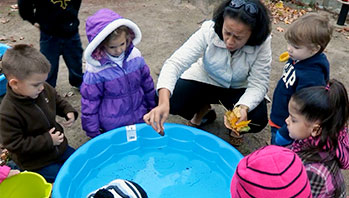- bags (one for each child)
- box full of previously collected seeds
- camera or cell phone with camera
- magnifying lenses
- old socks (pair for each child)
- cause
- seed
- travel
MA Standards:
Language/L.PK.MA.6: Use words and phrases acquired through conversations, listening to books read aloud, activities, and play.
Language/L.PK.MA.5.a: Demonstrate understanding of concepts by sorting common objects into categories (e.g., sort objects by color, shape, or texture).
MA Draft STE Standards:
Life Sciences/From Molecules to Organisms: Inheritance and Variation of Traits/LS1/3.A: Describe/draw and compare the body parts of animals (including themselves) and plants they are investigating [System] and explain functions of some of the observable body parts. [Structure and Function]
Life Sciences/From Molecules to Organisms: Inheritance and Variation of Traits/LS1/3.C: Use their sense in their exploration and play to gather information. [Structure and Function]
Head Start Outcomes:
Logic and Reasoning/Reasoning and Problem Solving: Classifies, compares, and contrasts objects, events, and experiences.
Science Knowledge/Scientific Skills and Method: Observes and discusses common properties, differences, and comparisons among objects.
Language Development/Expressive Language: Uses increasingly complex and varied vocabulary.
PreK Learning Guidelines:
English Language Arts/Language 2: Participate actively in discussions, listen to the ideas of others, and ask and answer relevant questions.
Science and Technology/Life Sciences 10: Observe and identify the characteristics and needs of living things: humans, animals, and plants.
Mathematics/Patterns and Relations 8: Sort, categorize, or classify objects by more than one attribute.
Explore Together (outdoors): Seed Scientists

© Commonwealth of Massachusetts, Department of Early Education and Care. All rights reserved.
STEM Key Concepts: Many foods that animals, including humans, eat come from plants; We eat certain leaves, roots, fruits, and seeds; Fruits have seeds; Seeds hold what a plant needs to make more of itself; People and other animals interact with their environment through their senses
ELA Focus Skills: Compare and Contrast, Listening and Speaking, Predicting, Vocabulary
Educator Prep: Before the activity begins, collect seeds from outdoor plants. Before the day of the activity, go outside and find a safe, clean area that has weeds, plants, etc., for children to explore.
Safety Tips:
- Remind children to wash their hands before and after the activity.
- Take children’s dietary needs into account before introducing them to any food items.
- Be aware of and check for poison ivy, poison sumac, and thorny or prickly bushes before gathering children in a designated area.
- Remind children not to eat ANY plants or touch any plants without asking an adult.
Tell children they are going to go outside to find seeds and explore how they travel. Explain that children will collect plant seeds in their bags. Some seeds they will collect for a later activity and for some seeds they will predict and explore how they travel. Ask questions such as,
- What happens when a seed travels from one place to another?
- Why is it important for seeds to travel from one place to another?
Explain that when seeds travel to another place, they sometimes get pushed into the ground and begin to grow in that new place. Ask, What do you think causes a seed to get pushed into the ground?
Then explain how important it is that seeds travel to other places, for example, so there won’t be too many in one area and so the roots and plants will have space to grow.
Before taking children outdoors show them the box full of seeds that you’ve collected beforehand. Let them touch and examine the seeds. The point of the box is to let children interact with seeds, get an idea of what they look like, and make their own observations and assumptions about seeds. Then take children outside.
Once outside, give each child a bag for collecting seeds. Review the safety rules for exploring outside. Then walk around the neighborhood while children look for and collect as many different seeds as they can. Record the explorations by taking pictures or a video.
As children explore ask questions that will prompt them to think about the relationships between seeds, animals, and nature, such as,
- What do you think the squirrel is going to do with the acorns it is holding?
- What do you think will happen if you blow on the maple seed? Try it.
Reflect and Share
Once inside, have children use their seeds to share what they observed. Encourage children to ask questions of other children’s observations. Help reinforce children’s understanding by asking questions such as,
- Lin, I noticed you had a maple seed that floated down gently when you blew on it. Why didn’t the same thing happen when you blew on the pumpkin seeds you found?
- What do you think the birds were looking for on the ground? What do you think they will do with any seeds they find?
- What seeds traveled the farthest? Why do you think so?
Tell children they will use their collected seeds in another activity. Have them write their name on their bags before leaving the group.
Take It Further: If possible, find a field or safe vacant lot with lots of weeds for children to explore. Give each child a large pair of socks to put over their shoes. Then let them walk in the field with the large socks on over their shoes. Once they come out of the field, have the children look for seeds stuck to their socks and add them to their bag.
